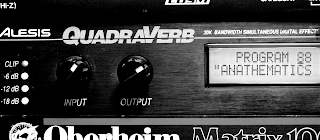Thursday, February 12, 2009
gorgogliatore
Here is a track that uses a bunch of field recordings. The recordings were made with a Zoom H2 recorder. It is a bit like having a point and shoot camera, only for audio. If you use one of these things enough, you start to think about the sounds around you a lot more. That can be a blessing and a curse.
The most obvious recording in the piece is the bubbling sounds. Inspired by John Keston's post on the Audio Cookbook, a straw and glass of water were pressed into service. John recommends pitching the sample down and using loads of reverb which is good advice.
In the background there is a recording I made of a thunder storm. Part of it is posted on freesound.org here. The Zoom recorder is stereo which is great for capturing the rolling effect of thunder. If you like thunderstorm recordings, there is a R.Humphries on freesound.org who posts some amazing recordings.
The heart beat sound was made by wobbling a piece of stiff plastic Rolf Harris style. There are some bits and pieces from the kitchen rattling around too. Playing around with the playback speed of the samples gives them a totally different feel. There are some good tips for getting neat sounds out of everyday objects in this SOS article and on the Audio Cookbook site.
Often the mistakes in your recordings are the bits you end up using; the thumps and rattles as you setup the mics or the sound of your own breathing. A bit like what Kim Cascone is talking about in his paper The Aesthetics of Failure.
Sunday, February 1, 2009
fun with your alesis quadraverb

Quadraverbs are crusty sounding old rack mounted effects units. They clip far too easily. The stereo inputs are summed to mono before the effects processing. All the sound editing is done via strange pressure sensitive up/down buttons that scroll the values faster if you press harder. The reverbs are crappy and noisy and everything going through it comes out sounding gritty. Despite all this, the Quadraverb is a fun toy to have around.
The highlights of the Quadraverb are...
1. Midi Modulation
There are eight midi controller routings in the Quadraverb. That means you can connect a midi controller and tweak eight different parameters at once. Just about any effects parameter can be mapped to a controller. However, like most older midi gear, the Quadraverb can get a bit overwhelmed by too much midi data.
Here's a clip of a drum loop running through the Quadraverb with the delay time and feedback being modulated in realtime. I used midi clip envelopes in ableton live so the modulations create a loop.
2. Resonators
The resonators patch in the Quadraverb consists of 6 resonant filters. The twist is that the frequency of the filters is controlled by midi. This means you can play the filters with a keyboard or a sequencer. It seems to work best on percussive sounds. Here's a sample of a drum loop running through the resonator while it's triggered from a midi keyboard.
3. Ring modulator
The ring modulator in the Quadraverb is a bit different to other ring modulators I've come across. It splits the ring modulator into two outputs, an "Up" and a "Down" which according to the manual are the frequencies above and below the modulator frequency. According to Sound on Sound magazine they are the Sum and Difference outputs.
Ring modulators require two different signals. The quadraverb ring modulator has a built in oscillator for the second signal. It is a sine wave and ranges from 0-300 Hz which is a bit limiting compared with the moogerfooger ring modulator which goes up to 4000 Hz. The interesting sounds come out when you vary the oscillator frequency via midi.
Here is a sample of a sine wave fed into the ring modulator followed by some reverb and delay. The frequency of the ring modulator is being varied via midi.
It's all in the name of science. Weird Science.
There is a great article in Sound on Sound about creating "strange ethereal textures". The quadraverb is mentioned several times, in particular it's ring modulator and resonators. I followed some of the tips in the article to create a texture from the ring modulated sample above.
The ring modulated sound needed more "body" so I added a layer of bass using a low pass filtered triangle wave.
The SOS article mentions adding gentle percussion sounds in the background gives a pad a more haunting sound. You can hear this trick on the Roland JV synths where they use an Angklung loop in the background of some of the Pad sounds. Not having an Angklung handy, I settled for a recording I made of some cutlery rattling around in the kitchen sink. Liberal amounts of reverb and delay where applied. I read somewhere that delay is sonic MSG, in which case this sample is Singapore noodles at the Lucky Dragon Restaurant.
The final sample was made by mixing the three layers in ableton live using clip envelopes for the individual volumes.
The layered sample was then loaded into a sampler (actually the simpler plugin) and a bunch chords were played. It's not quite Eric Persing but the result is kind of strange and ethereal. If you are interested, the individual wav samples are here.
Subscribe to:
Posts (Atom)